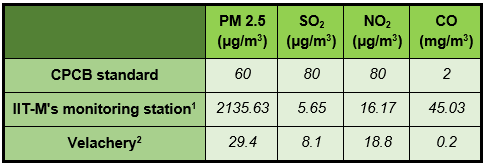{We thank Prof. Ligy Philips, the Chairman of the Engineering Unit and Prof. P. Sriram, the Dean of Administration for their inputs.}
On 15th December 2015, NDTV ran a story reporting that IIT Madras is the second most polluted place in the country. The article stated that according to the air quality data collected by a monitoring facility of the Central Pollution Control Board of India (CPCB) stationed at the Velachery gate of the campus, the value of small particulate matter (PM 2.5 value) was 474, which is about eight times more than the prescribed standard of 60 micrograms per cubic meter.
For anyone who has been in the campus though, excessively high pollution levels seem absurdly ridiculous to believe. To get to the root of the matter, we spoke to the Chairman of the Engineering Unit, Prof. Ligy Philips, whose research interests include air pollution modelling and control.
As a part of the National Air Quality Monitoring Programme (NAMP) which is a nation-wide programme to ascertain air quality standards, the CPCB had established a network of 342 stations to monitor air pollution levels across the country. These monitor the presence of NOx (oxides of nitrogen), SOx (oxides of sulphur), ozone, respirable suspended particulate matter (RSPM/PM 10/PM 2.5) and other common pollutant levels in etc. in the atmosphere.
Among the three stations in Chennai, the one located in IIT Madras monitors the air quality in Velachery. Examining the values generated by this station in the past shows that the recorded values have never exceeded the prescribed limits set by CPCB. However, between the period of 12th Dec – 15th Dec, some of the instruments showed unbelievably high data, as much as hundred times the usually recorded values. The following table shows a comparison of the values recorded by the CPCB station during this period and IIT-M’s independent study conducted a year ago:

The extent of error in the readings of PM 2.5 and CO sensors is put in perspective when compared to the CPCB standards. An investigation by CPCB into the sources of this error, found out that some of the electrochemical sensors had been affected by moisture and internal oxidation during the floods. Additionally, the software had got corrupted due to power outage and voltage fluctuations. CPCB said the following in a clarification letter addressed to IIT Madras –
“After the rain, the monitoring station at IIT Madras, Chennai started on Saturday (12.12.2015) and was put up for warm up. It was observed that all the analysers had been subjected to very high moisture and the flow path of the sampling tubes and sensors were contaminated due to internal oxidation. In addition, the software also got corrupted due to high voltage fluctuation. Hence, the entire system need to be flushed for long time and then, servicing and maintenance of each analyser and its flow paths need to be done once the maximum flushing and residue are removed.”
Until NDTV ran the story though, this wrong data was transmitted in real-time to CPCB centre, where it was uploaded onto the CPCB – CAAQM website without further validation. As of now, real-time measurements of PM 2.5, CO and Ozone in all Chennai stations have been taken down by the CPCB from its website, possibly to give some downtime for stabilizing and re-calibrating the instruments.
When asked about earlier instances of erroneous readings, Prof. Ligy told us that several professors working on air pollution modelling found data generated from the PM sensors to be wrong and reported the same to CPCB a few months back.
This episode naturally raises a question as to how representative of IIT Madras, is the IIT Air Quality Monitoring Station’s data. According to Prof. Ligy, the station’s location and hence the generated data is more indicative of the Velachery area than the campus. An independent air quality study by IIT-M during March-June 2014, does indeed show that IIT-M is one of the greenest spaces in the city, with pollution level values just about the same as the Guindy National Park. This data was submitted to the SEIAA (State Environment Impact Assessment Authority (SEIAA) of Tamil Nadu) last December.

Overall, this seems to have been a case of both incorrect data generation/usage and misinterpretation of the same. Prof. Ligy told us that to avoid misinterpretation of data as representative of IIT Madras, the institute management is looking at revising terms of MoU (Memorandum of Understanding) with CPCB to change the name of the station appropriately and reflect its location in Velachery.



